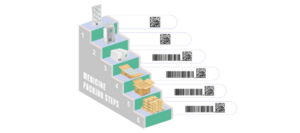
Table of Contents
Discover the SFDA requirements and Track & Trace specification for Saudi Arabia
Saudi Arabia is one of the most dynamically developing Pharma markets in the MENA region. The market is estimated to reach USD 11 billion in 2026, almost as big as Egypt and the UAE combined. COVID-19 impacted the Saudi Drug Market, driving its growth and is expected to exhibit a CAGR of 7.3% over the forecast period (2020-2027). Introducing a track-and-trace system in Saudi Arabia is part of the Saudi government’s Vision 2030 program.
The Healthcare Transformation Project has been ongoing since 2018, setting three goals to improve access, quality, and value. Moreover, unlike in Europe, a complete track-and-trace system includes the introduction of aggregation processes. By 2030, Saudi Arabia wants to track all medicines and healthcare products registered for human use, domestically and internationally. The health regulatory body will remain the MoH by 2030, as “this will be one of the largest healthcare transformations in the world in terms of many centres, size of population served, and complexity.”
Saudi Drug Food Authority (SFDA) published version 6.1 of Drug Barcoding Specifications, which provided information regarding the latest serialization and aggregation requirements and recommendations. SFDA believes that a standardized identification system from manufacture to patient delivery is imperative to comply with the increasing need for product integrity and traceability, endorsing the implementation of GS1 Standards.
The main noted objections are in the direction to following:
Increase patient safety
Reduce medication errors
Enable the tracking of each unit of a drug in the supply chain which will lead to:
- Detect counterfeits
- Ensure traceability and fast product recalls and withdrawals
- Ensure accurate, real-time information flow among stakeholders
- Support the optimal use of drugs
Serialization Requirements
All drugs’ markings must be upgraded from linear barcodes to GS1 Data Matrix barcodes, including the following:
- GTIN
- Expiry date
- Batch number
- Serial number
Aggregation Requirements
Aggregation is required to be done by the manufacturer on the different packaging levels to make it easier for the distributor down to the supply chain to track and report to SFDA on each unit of drug movement without having to scan the individual box of medication.
- Secondary Packaging – GTIN, Expiry date, Batch number, Unique Serial number on each box
- Carton/ case pack – Linear barcode or GS1 Data Matrix encoded with SSCC or GTIN + SN; GTIN + SN will be used only with homogenous case/cartoon
- Pallet – Linear barcode or GS1 Data Matrix encoded with SSCC or GTIN +SN; GTIN +SN will be used only with homogenous pallet
* Homogenous: the carton or pallet will only contain drugs of the same type.
** Heterogeneous: the carton or pallet will contain drugs of a different type.
Product List
The products that require the use of barcodes for serialization and aggregation are:
- Human drugs that are packaged and ready to be sold
- Herbal and Health products that are packaged and ready to be sold will require barcoding in the future.
- Veterinary pharmaceutical products that are packaged and ready to be marketed will require barcoding in the future.
The exemptions are free samples of pharmaceutical products, nonregistered drugs ordered by hospitals for specific patients and in particular quantities, drugs cleared for personal use and drugs removed for repackaging purposes.
Sources:
https://www.sfda.gov.sa/sites/default/files/2021-03/DrugBarcodingSpecificationsEN.pdf






